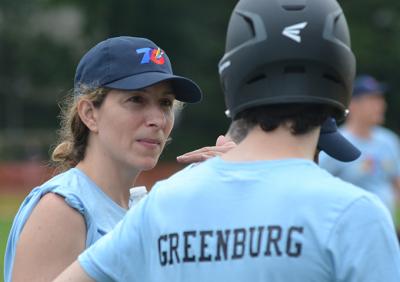Harassment Charged After Bikini Photos
Harassment Charged After Bikini Photos

In a confrontational matter that began the day after Memorial Day, a number of East Hampton Village’s female lifeguards have accused village beach managers of sexual harassment and the creation of a hostile work environment.
The allegations stem from incidents in which managers asked the women to model the bikinis they had collectively chosen as their new uniforms, and in at least one instance to pose for a photo that the lifeguards believed would be sent to the village board so that it could determine whether the suits were too skimpy.
Becky Molinaro Hansen, the village administrator, who interviewed nine employees during a six-week investigation into the matter, said there was insufficient evidence to conclude that anyone’s conduct had risen to the level of sexual harassment. On Monday, she said that the village board had never asked to see a photo of a female lifeguard modeling a swimsuit. That image has been deleted from the cellphone it was on, she added.
In a report to the board on Aug. 17, however, she said the swimsuit selection process “should have been handled better” by the beach administration, including Newt Mott, manager; Robert Barber, Ed McDonald, and James Nicoletti, assistant managers, and Rose Lawler, the office manager.
Christina Cangiolosi, a lieutenant lifeguard, was one of the women asked to pose in the new bikini. She said she felt coerced, even after she had informed management that neither she nor her colleagues were comfortable with doing so.
“They made me want to cry,” she said. “Throughout the summer, I’m there on red-hot days, pulling kids out of the water — we all are, as a team — and all any of the managers seemed to care about was the bathing suit that I’m wearing.”
In her report, Ms. Molinaro said that on May 29, the village board notified her that it wanted to change the uniform for female lifeguards. “Specifically, the board wanted uniforms that provided more coverage,” she said.
That news, Ms. Cangiolosi said, was relayed to the lifeguards by Mr. Mott. “All the girls got together and decided on the bathing suits that we wanted,” she said, and Mr. Mott, after being shown an image of the suits on a website, had approved them.
When the suits arrived, Ms. Cangiolosi said, members of the management team asked two female lifeguards to model them, and one was photographed with a personal cellphone. “She was asked to have her butt photographed in the bikini because they said the board had to either approve or not approve the suits,” Ms. Cangiolosi said.
In an interview this week, Ms. Hansen confirmed that such a photograph had been taken and that a female manager, presumably Ms. Lawler, had been the photographer. She stated that there was no “intent to humiliate, degrade, or embarrass” the lifeguard.
Ms. Hansen said she did not personally interview the lifeguard in the photograph, but had determined there was enough evidence, based on discussions with other employees who were in the office at the time, to conclude in her report that the “employee volunteered to be photographed, and that it was done in a light-hearted, comical manner.”
Before the village board got a chance to weigh in on the new uniform, however, beach managers decided among themselves that it was too revealing, and a different one was ordered.
This time, “they didn’t ask us for our opinions,” Ms. Cangiolosi said.
No other guards wanted to say anything publicly, she said, but “I’m the oldest female guard there, I’ve been there the longest, and that’s why I’ve taken on more of a leading role speaking out.”
When the next batch of suits arrived, she said, managers asked a secretary to call the lifeguards over the radio to ask, “Does anybody want to come up and model them for the managers?”
“I asked the girls on my stand, I asked the girls on the other stand, and they were uncomfortable. They didn’t want to do it.” Later that day, she said, she was called into the managers’ office to meet with Mr. Mott, Mr. Nicoletti, and Ms. Lawler. “They were like, ‘You need to put this suit on now, we have to see what it looks like.’ ”
She recalled responding that she was “ ‘not comfortable doing this, and I’m especially not comfortable if you want to take a photo of me.’ Newt said, ‘What’s the big deal? We see you in your bikini all the time.’ And I said, ‘That’s not the point. I’m on the beach in my bikini because that’s what we do. It doesn’t mean that you can take a picture and be creepy about it.’ ”
Mr. Mott declined to comment and referred any questions to Ms. Hansen.
Ultimately, Ms. Cangiolosi said, she felt pressured to cooperate, and agreed to put on the suit in the women’s locker room and allow Ms. Lawler to look at it, but not photograph it.
Mr. Nicoletti confirmed that Ms. Cangiolosi tried on the suit for Ms. Lawler, but said she had not been pressured. “The instance that you’re talking about was a full-coverage bathing suit,” he said. “That’s where I’m, like, where is the pressure? She tried on a suit with a lot more material than the one she was wearing.”
Ms. Cangiolosi said the experience made her feel “horrible.”
“Of course, I felt uncomfortable with Rose looking at me, but I felt stuck,” she said. “I felt like that was my only option without having these men staring at my butt. Meanwhile, the suit that I’m wearing is comfortable, and it’s not falling off. It’s not like I’m wearing this slutty bathing suit. It works as an ocean lifeguard suit. And, I’m doing my job.”
The replacement suits were approved, but the female lifeguards were not fans of the choice. “They’re uncomfortable, they’re not supportive for bigger-chested women, and sand gets in them,” Ms. Cangiolosi said. The women wore the suits for a couple of days to be “respectful” to their bosses, she said, but soon went back to wearing the suits that were deemed too revealing.
She claimed that Mr. Mott had repeatedly threatened to fire anyone who didn’t wear the new suits. He never followed through, but “morale was just awful,” she said.
Ms. Hansen, the village administrator, said the policy is that “employees are required to wear village-issued uniforms.”
Hoping to improve matters, the female lifeguards set up a meeting with the beach managers. The group also presented them with a letter, jointly written and addressed to the members of the village board, stating that two of their number had been photographed “modeling bikinis for the managers in their office.” The incidents, they wrote, “left many of the guards feeling degraded, embarrassed, and confused.” The letter said that they wanted to register a formal complaint about the “odd process to view and approve the suits.”
The managers refused to accept the letter as written, Ms. Cangiolosi said. When they read it, she alleged, “They were totally defensive and never apologized for anything. They started attacking me and said, ‘Are you sure you remember that correctly? You know, sometimes when you get flustered you might not recall correctly.’ ”
Village officials did finally receive a version of the letter, which was released to The Star following a Freedom of Information Law request. “Although I never received a signed copy of the complaint, it is my understanding that certain beach employees authored the complaint,” Ms. Hansen said in her report. There was “no evidence to suggest that any employee intended to intimidate anyone,” she said.
Ms. Hansen had a meeting with the managers on Aug. 8, at which, she said in her report, she pointed out certain errors in handling the selection-of-suits process. “There was a lack of judgment and failure to timely advise me of what had transpired,” she said.
Later that day, she met with Ms. Cangiolosi and at least one other lifeguard, who she believed to have coauthored the complaint letter. She apologized to them for how the process was handled, and informed them that supplemental training for the managers would take place.
Ms. Cangiolosi, who attended the meeting with her parents, was not satisfied with Ms. Hansen’s response. “So you’re not going to apologize for the way the managers have spoken to us? The things I’ve had to deal with this summer? Why you even made us put full-coverage suits on in the first place? The threats to be fired or sent home? I’ve felt uncomfortable this whole summer and I wanted to quit like three times, which is just awful because I love my job.”
She was particularly put off, the lifeguard lieutenant said, because Mr. Mott had been invited to sit in on the discussion. Asked Tuesday to explain his presence, Ms. Hansen said she would not discuss who was in attendance.








